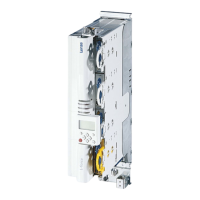EDS94ARNExxxx EN 2.3 - 06/2014 L 135
9400 regenerative power supply module | Parameter setting
"CAN on board" system bus
Monitoring
6.9.1.1 Telegram structure
RTR telegram
The RTR telegram from the NMT master has the following identifier:
Identifier (COB-ID) = 1792 + node address of the NMT slave
The RTR telegram does not contain any user data.
The RTR bit in the arbitration field of the RTR telegram is set to the LOW (dominant
level).
Response telegram
The response telegram of the requested NMT slave has the same identifier as the RTR
telegram received from the NMT master
The user data (1 byte) contain the NMT slave state and the toggle bit (see below
description).
NMT slave state (s)
Toggle bit (t)
The toggle bit (t) of the response telegram has the value "0" when the node guarding
protocol is activated for the first time.
The value of the toggle bit (t) must change with every response.
NMT slave state Data
Communication state Decimal value
(s)
(t) NMT slave state (s)
Bit 7 Bit 6 Bit 5 Bit 4 Bit 3 Bit 2 Bit 1 Bit 0
Stopped 4 0/10000100
Operational 5 0/10000101
Pre-operational 127 0/11111111
Note!
The toggle bit is monitored by the NMT master.
If a telegram is received with the value of the toggle bit not being changed, it will
be treated as if it had not been received; i.e. the monitoring time is not reset and
continues to pass.
The toggle bit can only be reset to "0" by the NMT master via the "reset
communication" telegram.

